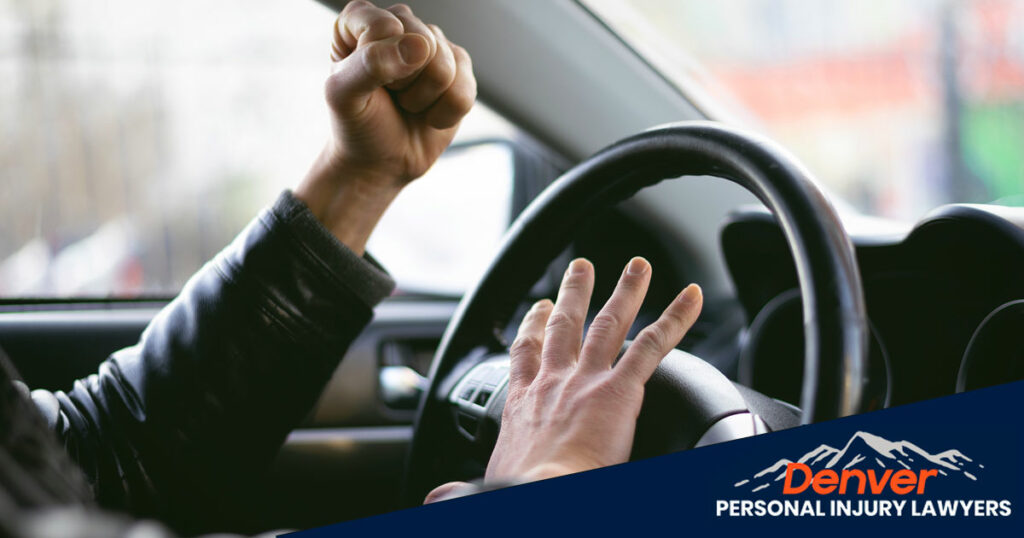Aggressive driving happens all the time, and it’s not something to be taken lightly. When someone drives in this manner, it puts us all at risk.
Aggressive driving is one of the leading causes of crashes in the US. A person’s inability to control themselves while driving can change another person’s life forever if they cause a severe collision.
After an accident, drivers must pull over to exchange information. It’s best if everyone can be rational and stay calm. However, aggressive drivers might have trouble controlling their emotions, adding even more tension to a stressful situation.
There are a few things you can do to keep the situation from further escalating and help you stay safe after an accident with an aggressive driver. Here’s what you need to know if you were involved in a crash with an aggressive driver.
Table of Contents
ToggleWhat Is Aggressive Driving?
The National Highway Traffic Safety Administration (NHTSA) defines aggressive driving as any driving behavior where an individual commits a traffic offense and poses a danger to other drivers and their property. Examples of dangerous, aggressive driving behaviors include:
- Reckless driving
- Excessive speeding
- Following another car too closely
- Unsafe and erratic lane changes
- Running through red lights
- Driving on the shoulder or sidewalk
- Driving over a median
- Ignoring stop signs and other traffic signals
- Passing through prohibited zones
- Not using turn signals
- Ignoring signals from other drivers (not letting other drivers merge)
- Failing to yield to the right of way
- Making erratic lane switches, turns, or stops
- Taking out anger or frustration on another driver or motorist.
Facts About Road Rage
Aggressive driving is a broad term referring to dangerous driving behaviors. An aggressive driver can spiral out of control and turn into a case of road rage. Road rage is the “willful and malicious disregard for the safety of other drivers, often involving the physical assault of a person or vehicle. People with road rage use their vehicles as a weapon to harm others and their property.
Here are some statistics about road rage in the US:
- In a seven-year study on traffic trends, there were 12,610 injuries resulting from road rage and 218 murders
- 37% of all road rage incidents involved the use of a firearm
- Young male drivers are the most likely population group to exhibit road rage.
- Almost half of all drivers who are initial victims of road rage report responding with aggressive behavior.
The National Safety Council has released the following guidelines for anyone who encounters an aggressive driver (NSC):
- Keep plenty of distance between yourself and the angry driver.
- Call 911 if you are worried about your safety.
- Avoid gestures that may further provoke them, like a hand or facial gestures.
- Avoid eye contact.
What Makes Some People More Prone to Road Rage Than Others?
According to American Psychological Association (APA), certain thinking patterns and personality traits make some people more likely to have road rage than others.
Psychologists say that in order to change behavior, we must understand it first. According to studies from the APA, here are the key differences between “high-anger drivers” and “low-anger drivers”:
- Angry drivers have hostile thinking patterns (e.g., insults or disbelief about the way others drive)
- Angry drivers take more risks on the road. According to studies, aggressive drivers are likelier to go 10 to 20 mph above the speed limit, tailgate, make abrupt lane changes, and run red lights.
- Aggressive drivers get angry faster. They are also more likely to swear, name-call, and honk. Lastly, they are more likely to act this way throughout their day in their normal lives, not just behind the wheel.
- High-anger drivers have twice as many accidents as “low-anger” drivers, get more tickets, and have more near-accident experiences.
- High-anger drivers usually have personality traits like impulsiveness and extroversion. They are also more likely to experience anxiety.
Aggressive Drivers Often Cause Speeding Accidents
According to data from the Governors Highway Safety Association (GHSA), bout one-third of all traffic fatalities are caused by speeding. Speeding is when someone drives too fast in the given conditions or exceeds the posted speed limit. Here are some more statistics reflecting aggressive driving:
- In 2020, there were 11,258 deaths in crashes where at least one driver was speeding.
- Speeding caused almost 30 percent of all traffic fatalities in 2020.
- Speeding is a major cause of traffic accidents in the US that cause fatalities and severe injuries.
- The estimated annual cost of speeding-related traffic accidents is $40.5 billion. That’s almost $77,000 every minute.
Teen drivers are more likely than other drivers to be involved in a speeding-related crash. Speeding is dangerous because it gives drivers less time to react in dangerous situations and reduces the ability to safely steer around objects or other cars. Additionally, when a car is traveling at high speed,
Tips for Dealing With an Aggressive Driver
Here are some guidelines to help you stay safe when dealing with an aggressive driver.
Don’t Argue With the Angry Driver
Your foremost priority should be ensuring everyone’s safety. Concentrate on dealing with injuries or staying safe rather than confronting the other driver. For example, if the other driver is aggressive, don’t engage with them. Or, if they appear to be under the influence of drugs or alcohol, it’s best to keep communications short or avoid it together.
Even if you feel threatened by the aggressive driver, try not to react confrontationally. Do your best to stay calm and collected. And be sure to get their contact information. This might be difficult with someone who is having an outburst of anger. Step back, give the space, and prioritize your safety.
Park Park in a Public Area If Possible
It might seem bizarre, but sometimes aggressive drivers follow people to their destination. Don’t go home if you fear that an aggressive driver will get out of the car and attack you. Instead, drive to a public parking lot. This is more likely to discourage them from escalating their aggression into a physical assault.
Stay Inside Your Car
If your car is not too badly damaged, stay inside. Lock the doors and close the windows while you wait for the police to arrive.
Inform the Aggressive Driver That You Have Contacted the Police
In most car accident cases, you’ll be legally required to contact the police. If property damage exceeds $500 or there is bodily injury or a fatality, you must call the police. Even if none of those apply, if you feel threatened by the aggressive driver, you can still call the police. Stay calm and rational when the police arrive, as they will take note of your behavior. This will all be documented in the official incident report.
Stay Calm but Be Prepared
If you are overly riled up, you won’t be able to think straight. You’ll need to think rationally to ensure you take the right steps to protect yourself and your injury claim. Be prepared to exchange information with the police, the other driver, and witnesses.
You’ll also want to take pictures of the accident, any injuries, and property damage. If you’re overly worked up, you’ll forget to do important things that will be helpful to your case later. So try to remain calm.
Contact a Denver Personal Injury Lawyer
If you need legal representation, it’s best or get it soon after the accident. Once you’ve gotten the appropriate medical treatment and dealt with law enforcement officials, it’s time to start thinking bout compensation. An attorney can help ensure you get the most compensation for any injuries and accident damages caused by an aggressive driver.
Legal Help for Aggressive Driving Accident Victims
If you sustained injuries in a car accident caused by someone’s aggression or road rage, consult with a knowledgeable Denver car accident attorney.
Our legal team has handled countless car accident cases and knows how to evaluate the facts and gather strong evidence. We can help establish the other driver’s aggressive behavior and negligence that caused the accident and any consequential injuries. Most importantly, we will fight tirelessly to win you fair compensation for all accident damages.
Contact us today for your free initial case review.
















